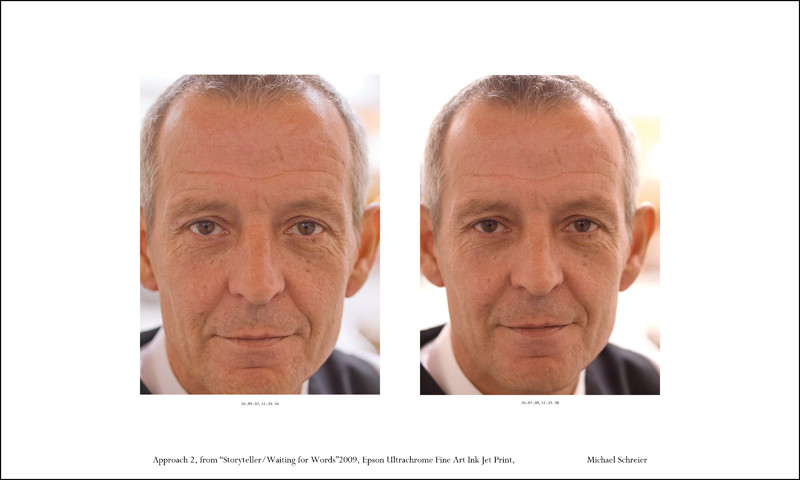[Spring 2010]
The Ottawa Art Gallery, Ottawa
September 10 to November 15, 2009.
Disquieting, painterly, poetic – these words come to mind on viewing Michael Schreier’s series of large-scale grey/blue/purple semi-abstract photographs, Disappearing Numbers (2007-20-09), and Or-Sarua (2009), which portray empty bunker-like interiors quietly resonating with a sense of tragedy. Despite their softened forms and the occasional shafts of luminosity that open up the closed spaces, Schreier’s ambiguously rendered rooms echo with alienation and loss. Belying their origins, they exude a palpable sense of imprisonment through their depiction of hard concrete floors, high walls, and passages without exit. Schreier recorded the source images in the basement-level remains of Vienna’s Or-Sarua synagogue (destroyed in 1420–21 during the persecution and murder of Vienna’s Jewish community in the Middle Ages,1 part of the Museum Judenplatz and Holocaust Memorial.2
Schreier’s meticulous planning and conception for the Ottawa Art Gallery exhibition includes the dramatic colour of the walls – an imperial red taken from the Austrian national flag3 – that provides a cultural context and also lends a totalitarian air. In the adjacent gallery, the same colour provides continuity of culture and place for Waiting for Words: The Vienna Portraits, a portfolio of close-cropped photographs of faces taken on the street.4
The Or-Sarua installation is composed of seven 83 x 44 cm vertical images, each edged with a black border, that hang likebanners between two cylinders. The allusion to imperial military signage is unavoidable and serves the images well, as their dark subterranean spaces speak of incarceration and worse. From left to right, the first three banners offer cool, geometric images of gargantuan concrete walls and surfaces with hints of other inaccessible spaces, occasionally alleviated by patches of light. The last three images, tinted a dark, unctuous red, depict the jagged edges of bare concrete stairs that lead ever downward. The surfaces of all seven images are haunted by ghostly numerical sequences shown in reverse; one sequence,23..09..07, in intense blue, pierces the background of burgundy-hued steps. The mirror-image numerals appear as undecoded ciphers, marking perhaps the passage of time or the reckoning of an incalculable number. (A literal reading of the sequence – the date that the image was taken – is not immediately recognizable.) Or-Sarua can also be understood as a memorial – the seven banners standing for the seven candles of a temple menorah.5 Each of the three central banners incorporates a luminous shaft in varying degrees of intensity that provides space for hope.
The pieces in the Disappearing Numbers series are horizontal; each measures 34 x 48 cm. Their surfaces are also suffused with sequences of numbers – 02..09..07, 16..24..19; some are barely perceptible, others are truncated and create an eloquent metaphor for the disappearance of time and life cut short. In the artist statement for Disappearing Numbers, Schreier recounts a memory that surfaced in 2007, while he was in Vienna. The recollection involves his father advising him as a twelve-year-old, and about to be introduced to his father’s architect colleague in New York, not to refer or comment on “the numbers on [the man’s] arm.” Architecture, unspeakable numbers, and the human body have evidently long been linked in Schreier’s consciousness.
Waiting for Words: The Vienna Portraits (2007) offers a counterpoint. These portraits depict the sumptuously detailed topography of anonymous faces, and offer the luxury of examining at length people from all walks of life. We observe the heavily applied make-up of an older woman, the angelic countenance of a child, and the hard-bitten lines of a middle-aged man. Many expressions reveal human foibles and fragility; most were captured by Schreier in moments without reserve, in an encounter between two strangers that has become a silent dialogue. A number of the portraits are jarring and perplexing; complexions are tinted with a strident orange or pale green, eyes are a penetrating blue or vivid turquoise, other, more subtle, digital colour shifts render faces at once alien and familiar. While most of the eyes are glossy with life, one woman’s gaze and resigned expression lack a glint of reflection, leaving her face a hard, sad, closed mask. Under each portrait is a sequence of numbers recording the date and time of day, down to the split second, of the willing encounter and nonverbal human exchange between the photographer and his mirror. On close observation, Schreier’s silhouette (the pose of the photographer; one arm bent over the head) is seen reflected in their irises, alluding to the question of who Schreier might have become if he had not immigrated as a child.
1 Michael Schreier, Artist Statement, Disappearing Numbers, 2009)2 The Judenplatz Holocaust Memorial is dedicated to the memory of the sixty-five thousand Austrian Jews exterminated by the Nazis during the Second World War. Jewish Museum Vienna, http://www.jmw.at/en.html
3 Conversation with Michael Schreier, November 11, 2009.
4 Schreier was born and spent his early childhood in Vienna; he immigrated to Canada with his parents in 1953. Schreier made his initial portrait exposures on the streets of Vienna while there on a solo sojourn in 2007; he also photographed inside the Jewish Museum Vienna on this trip. Conversation with the artist and Artist’s Statement, Disappearing Numbers, 2009. 5 Emily Falvey, curator’s exhibition statement, Storyteller/Waiting for Words, September 2009.
Judith Parker is an Ottawa-based art historian and arts administrator. She recently produced a short documentary video, Water, Light and Chaos: Art by Juan Geuer, with filmmaker Edward Folger.

